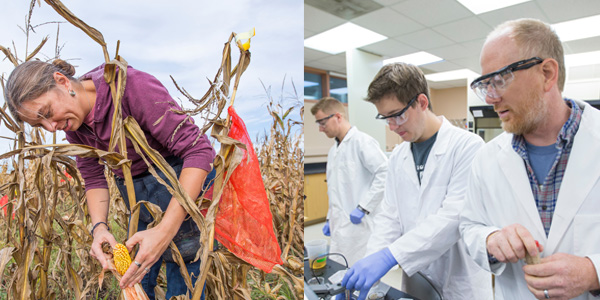
Strands of Corn Silk and DNA
Scott Nelson and Marna Yandeau-Nelson combine genetic and biochemical science at work with a home life of raising a garden, two kids, a dog and batches of beer.
She’s from upstate New York, came to Iowa to be a pharmacist, fell in love with corn, a guy who helped her unload her car and “field days.”
He’s from near Fargo, North Dakota, grew up loving science fiction, enjoys tinkering with antique engines, studying double-strand DNA breaks and sharing grant proposal drafts with his special someone.
The two conduct research that could some day—albeit years from now—take a bite out of cancer and dramatically boost crop yields.
Coulomb’s Law
Say hello to Scott Nelson and Marna Yandeau-Nelson, a physical example of Coulomb’s Law, something very few people can name, but everyone knows about.
“We’re very much an opposites-attract couple,” says Yandeau-Nelson, assistant professor of genetics, development and cell biology. French physicist Charles-Augustin de Coulomb proved the physics law of opposites attract and likes repel in the world of electromagnetism in 1784. William Shakespeare chronicled it as a romantic truth 200 years earlier.
“He’s a very even-keeled kind of guy,” says Yandeau-Nelson. “Things don’t upset Scott or get him excited much. I’m more of an emoter, I guess,” she says, with a laugh.
The two met in Ames in 1998 while both were in grad school at Iowa State. After enrolling in the Drake University pharmacy program, a summer job at Pioneer introduced Yandeau-Nelson (’05 PhD genetics) to the love of her professional life: Zea mays, aka corn.
“I think corn is such a beautiful, clever plant,” she says. “When you drive by the corn fields of Iowa, diversity’s not the word you think about. That’s because the plants have all been bred to be hybrids that give you reliable yield. But if you look at all the different varieties of corn, it’s like walking through a plant zoo. They’re different shapes and sizes and colors; it is just a beautiful plant.”
Nelson (’02 PhD biochemistry) was drawn to science by his childhood love for science fiction, along with his father’s work as an agricultural economics professor at North Dakota State University.
A matchmaking mutual friend was the catalyst for their personal chemistry. It led to their wedding in 2004 in the midst of a long-distance relationship while she earned her doctorate at Iowa State and he served as a post-doc at Penn State.
Five years later, they found two positions at their alma mater. Although both work in departments shared between the College of Agriculture and Life Sciences and the College of Liberal Arts and Sciences, they don’t work in the same research lab or building.
The Tale of Two Strands
Yandeau-Nelson studies genetic networks of plant cuticle lipids and their protective properties against environmental stresses. Cuticle lipids make up the waxy substance on the surface of plant leaves and corn silk. Understanding how these chemicals are produced could lead to advances in crop protection, including drought-resistant corn. Since these waxes are chemically similar to components of petroleum, the research could have biofuel applications as well.
Nelson is an associate professor of biochemistry, biophysics and molecular biology. He focuses on what’s been called the “keystone complex” of DNA repair, specifically related to double-strand breaks. Understanding how the body repairs severe double-strand breaks could lead to pharmaceutical breakthroughs. He also studies enzyme functions that could lead to advances in drugs to treat and prevent malaria and malaria-like diseases in humans and animals.
Although only about 25 percent of their time is focused on teaching with the rest on research, both list interacting with students as a highlight of their jobs.
“I like the fact we can teach and train and learn from doing those things, but we can do it in many different ways at different levels. It keeps things fresh,” says Yandeau-Nelson, who keeps her hands-on science game up via visits to her research cornfield.
Not only is Iowa State their beloved alma mater, but Nelson says the professional support is exceptional. “The biochemistry department is extremely close-knit, very collegial and the atmosphere is right.”
A Two-Scientist Home
If regimented order, neatness, scientific method and well-scrubbed stainless-steel rule a scientist’s workplace, does that carry through to a scientist’s home?
Not in this case, Yandeau-Nelson admits. Their home goes through the same cycles of tidy and disorganized as every home.
“Sometimes the neat scientists come home and they want to be the opposite of neat,” explains Nelson. There is some shop talk, though. “If you ask our kids (Ada, 10, and Ian, 7) they feel we talk about it way too often, but I feel like we don’t,” says Nelson.
“If there are issues in either of our labs we look to each other,” Yandeau-Nelson adds, “not specifics, but questions of styles, how to run a lab and things like that.”
“We cover for each other at home when someone is working long hours, but if Marna was a lawyer working late it would be the same thing,” says Scott. “There’s nothing intrinsic about the fact that we’re both professors on-campus that causes any problems. I think it’s only positives, really.”



